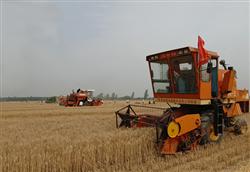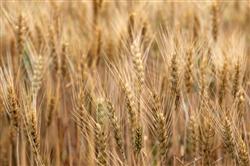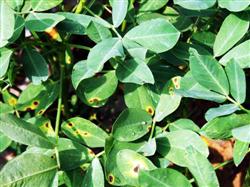How to reduce the loss of wheat combined harvest?

How to reduce the loss of wheat combined harvest? Is there any way to reduce the loss during harvest? In order to reduce the loss of wheat harvest, the following points should be done: select the appropriate operation period and operation time. The best time for wheat harvest is the end of wax ripening and the early stage of full ripening. The working time of the combine harvester should be determined according to the specific conditions of the weather, and generally adopt the principle of late departure and late closing. You can make use of this period of time when the crops are relatively wet in the morning to carry out a more comprehensive technical maintenance of the locomotive, and then close the car after the dew comes down in the evening. During this period of time, the harvest is not only high in efficiency, but also relatively small in loss. Maintain the appropriate stubble height. The height of stubble should be determined according to the height of wheat and the leveling of land. Generally, 15~25cm is suitable, and one-sided pursuit of high productivity should not make stubble too high. Otherwise, due to the difference in the height of wheat or the fluctuation of the cutting table when the locomotive crosses the ridge of the field, some wheat will be missed. At the same time, if the stubble is too high, the plucking effect of the plucking wheel is weakened, which is easy to make the harvested wheat fall to the ground and cause loss. Adjust the height, front and rear position of the reeling wheel correctly. The position of the reeling wheel should be adjusted according to the specific conditions of the crop. In general, its high and low position should make the plucking board act on the 2x3 of the cut crop, and its front and rear position should depend on the crop density and the degree of lodging, and when the crop plant density is high and lodging, it should be moved forward appropriately to enhance the ability of supporting crops. The position of the reeling wheel is on the high side, and the plucking board is easy to hit the head of the ear; in front of the position, the number of times of hitting crops with the pulley increases. All these are easy to cause grain shedding and increase the loss of the operation, especially in the later stage of the operation. Attention should be paid to the wear and tear of the threshing mechanism during maintenance. The wear of striated rod or nail teeth and the deformation and wear of concave grid will affect the removal rate of wheat. Therefore, the combine harvester which has been used for a long time must be checked before the harvest operation, and the deformed parts or seriously worn parts should be repaired or replaced in time. It is worth noting that this kind of repair should be carried out in the regular repair shop to ensure the stable work of the threshing drum. The speed and clearance of threshing drum should meet the technical requirements. The rotation speed of threshing drum and the size of threshing gap are important factors affecting wheat threshing rate. In order to ensure the stability of the drum speed, the speed must not be changed by changing the size of the throttle, and the method of reducing the throttle should not be used to reduce the speed when crossing the ridge of the field, and the crop should be fed evenly in the operation, and the feeding amount should not be too large, so as not to affect the threshing quality. The threshing interval should be adjusted according to the specific conditions of crop varieties, maturity and humidity. The adjustment principle: on the premise of meeting the threshing rate, the threshing gap can be appropriately increased to reduce the crushing rate of wheat and the probability of drum clogging. Always check the work of the scripter. In the whole process of combine harvester, the separation mechanism is the weakest link. The separation loss will be increased when the extrudate slightly exceeds the rated input or when the stem is wet and the content of weeds is high. Therefore, in the operation, it is necessary to often check the straw blockage in the key box of the scripter and remove the fault in time. The most commonly used methods are to reduce the amount of feeding, correctly select the harvest time and properly increase the stubble height and so on. Correctly adjust the opening of the cleaning screen and the fan air volume. The air flow sieve type is widely used in the grain cleaning device of the combine harvester, and its operation quality largely depends on its adjustment and coordination. In general, with the increase of the opening of the sieve and the appropriate reduction of the fan air volume, the cleaning loss can be reduced, but the cleaning rate decreases; on the contrary, the cleaning loss increases with the increase of the cleaning rate. Therefore, the adjustment should be considered as a whole, and the cleanliness rate should not be one-sidedly emphasized. The adjustment principle: in the case of ensuring that the cleaning loss rate does not exceed the standard, properly reduce the opening of the sieve and increase the fan air volume to improve the cleaning rate of grain. Harvest lodging crops correctly. Appropriate reduction of stubble to reduce missed cutting; plucking wheel moved forward appropriately, plucking spring teeth tilted 150 to 300, in order to enhance the supporting effect; for crops with serious lodging, measures such as harvesting in reverse lodging direction, reducing machine speed or reducing feeding quantity should be taken. Click to get more wheat planting technology click to get more grain planting technology
- Prev

How to determine the best harvest time of wheat?
How to determine the best harvest time of wheat? In what way can we determine that wheat is ripe for harvest? The best time for wheat harvest is the end of wax ripening, when the 1000-grain weight and yield of wheat are the highest. Harvesting too early or too late will lead to the decrease of 1000-grain weight and yield. At present, most of the wheat is harvested in the full ripening period.
- Next

How to prevent premature senility of peanuts?
How to prevent premature senility of peanuts? Please guide peanuts to prevent premature decline need to do the following: 1, select the site. Select the fields with higher fertility and apply sufficient base fertilizer to plough 25cm and 30cm in advance and dry ridges. Per mu, 2000 kg of rotten ring fertilizer or 25-35 kg of cake fertilizer, 50 kg of ternary compound fertilizer, 50 kg of phosphate fertilizer and zinc fertilizer.
Related
- The first cup of black tea in spring, the flavor and history of tea gardens in Kenya, Africa
- The computer can not only choose potatoes, but also grow tea rice. AI will grow winter oolong tea champion.
- It is not only the inflated tea bitten by insects, but also engraved with the four seasons tea in Beipu.
- The Oriental Beauty Tea Festival in Zhuxian County takes the stage at the weekend to experience the plus-size feast of oil tea.
- & quot; Oriental Beauty Tea & Exploration of Emei in Hsinchu, the hometown of quot;
- The new variety of strawberry "Tainong 1" dessert is the first choice with mellow aroma. Crimson gorgeous
- History of Tea in Taiwan: from Wild Inner Mountain to Export Tea Garden
- Two types of Taiwan Oriental Beauty Black Tea won the British three-Star Award for Childhood Tea Xiang Zhang Jiaqi changed from pilot to champion tea maker.
- Banana species and varieties: the planting history of Taiwan Xianren banana and dwarf banana is long, is banana disease resistant?
- Coffee planting Technology: Qianjie Coffee from Seedling to harvesting

